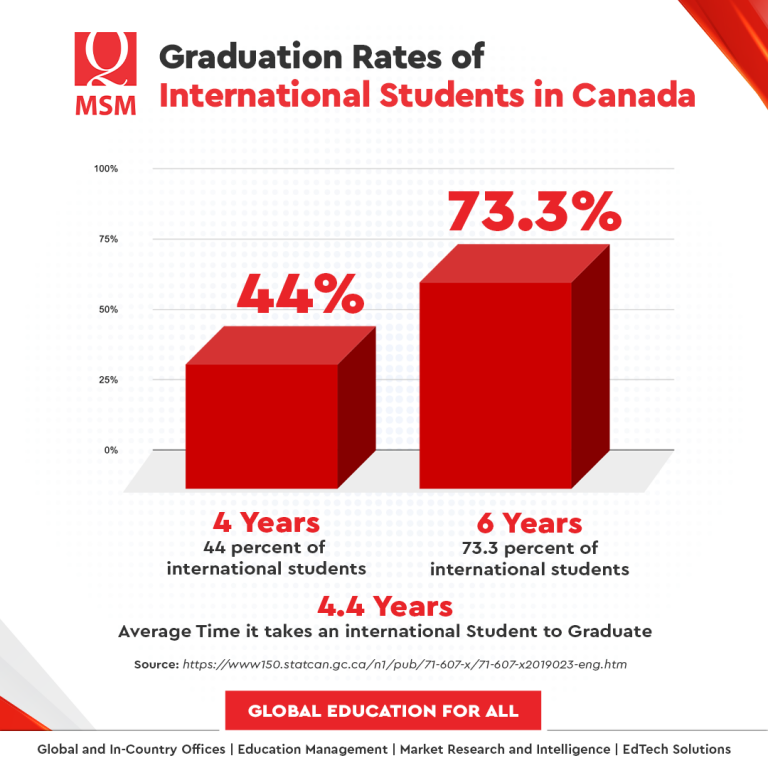Statistics Canada released data about postsecondary students in Canada and their persistence and graduation rates.
Key Points at a Glance
- An analysis looked into 10,176 international students who were pursuing undergraduate degrees, aged 15 to 19, in the entry cohort 2012/2013.
- Their persistence rates are as follows: 86.2 percent for their first year, and 79.1 percent for their second year.
- In terms of graduation rates, 44 percent completed their studies in four years, while 73.3 percent graduated in six years.
- Canada is a global powerhouse in international education, and pathways programs can be viable solutions in expediting students’ achieving their educational and professional goals.
A technical reference guide defines an entry cohort for this analysis as “students 15 years old and over… who first enrolled in their educational qualification in the specified academic year and who were enrolled full-time on the fall snapshot date of that academic year… Therefore, the number of students in each entry cohort is less than the total number of new students entering over the full academic year.”
It adds: “This means that the first cohort of new entrants that could be followed for the persistence and graduation indicators was that of 2011/2012, since the 2009/2010 and 2010/2011 data were used to identify which of the 2011/2012 students are actually new entrants. The new entrants could then be followed through to the fall of 2018/2019, the most recent year of PSIS data available at the time of release.”
For the purpose of this Insights article, it will focus on students aged 15 to 19, who were a part of the entry cohort 2012/2013.
International students
A data visualization tool of the analysis titled “Persistence and graduation of postsecondary students aged 15 to 19 years in Canada” highlighted the performance of the 131,817 young postsecondary students, and how they fared in terms of persistence after one year or two years, and the average years it took for them to graduate.
Of the total number of students, 10,176 of them were reported to be international students, making up 7.7 percent of the total entry cohort of 2012/2013.
In terms of gender, Canada received a balanced number of male and female postsecondary international students. The data reported 5,268 male students (51.8 percent) and 4,908 female students (48.2 percent).
These are students pursuing an undergraduate degree.
For students who pursued a career, technical or professional training diploma, there were 30,816 of them recorded as part of the entry cohort of 2012/2013.
Only 993 (3.2 percent) of them were international students—with 537 females (54.1 percent) and 456 males (45.9 percent).
Persistence, graduation rates
Of the 10,176 international students who pursued an undergraduate degree, 86.2 percent of them completed their first year. This number dipped during their second year, reporting only a 79.1 persistence rate.
In terms of graduation rate, 44 percent of undergraduate students completed their studies in four years. The numbers increased significantly in six years, as the graduation rate for these international students was at 73.3 percent.

With these numbers, the report found that the average time it took for an international student to graduate with a college or university degree was 4.4 years.
For those international students enrolled in a career, technical or professional training diploma program, the average time before graduation was 2.8 years. Only 36.3 percent of them graduated after three years, and 43.2 percent completed their studies in four years.
Pathways solutions
In recent years, Canada is seen as a global powerhouse in recruiting international students. From 2004 to 2014, the number of international students who were first-time study permit holders rose from 354,510 to 530,290. Most of these students recorded in 2014 were from countries like China (119,950), India (69,950), and South Korea (41,420). Rounding up the top 10 source countries were France, Brazil, Japan, United States, Mexico, Nigeria, and Vietnam.
In 2019, before the coronavirus pandemic, Immigration, Refugees and Citizenship Canada (IRCC) revealed that there were 642,480 international students in Canada. This was an 18 percent increase over the previous year. From this number, 498,735 of them were post-secondary international students.
Canada presents a number of advantages for international students: generally lower tuition and living costs as compared to in the United States or the United Kingdom; students can work while they are studying; and completing their studies may make them eligible for a Post-Graduate Work Permit, which in turn, could help them qualify for permanent residence in Canada.
However, despite all these, pathways programs offered by higher education institutions, in partnership with study centers and other educational institutions around the world, may allow international students in Canada to complete their studies in less than four or six years.
For instance, MSM Higher Ed Pathways offers the opportunity for students to start their courses from their home countries, which will allow them to save on tuition costs and living expenses, before completing their degree at an international institution.
“A large percentage of prospective international students plan to work in Canada after graduation (65 percent), and to apply for permanent residency (68 percent),” stated a study on retaining international students in Canada.
From study to work to permanent residence in Canada, pathways programs are viable solutions worth looking into to help expedite achieving one’s educational and professional goals. (SUNEETHA QURESHI)
Suneetha has more than 10 years of experience in the international education sector. As president of MSM GMO, she fortifies its business development outreach globally, particularly in the face of MSM’s foray in edtech-based recruitment via MSM Unify. She preserves the premium, value-adding services provided to each GMO partner institution, including dedicated teams on the ground, agent management, lead generation and inquiry management, application pre-screening, and student and parent support through pioneering pre-departure briefing sessions.
She has an impeccable track record of successfully launching the representative offices in Asia and Africa of many North American and European higher education institutions. Her key strengths include hiring, training, and developing teams as evidenced by the successful results of the dedicated in-country college and university client teams.
Suneetha also has taken the lead in developing several initiatives at MSM, including building robust standard operating procedures, the Rise ‘n Shine team engagement platform, and the organization’s data analytics and audit segments.
Data sources:
Data sources:
Persistence and graduation indicators of postsecondary students, 2011/2012 to 2018/2019 (2021, June 9) Statistics Canada. Retrieved from https://www150.statcan.gc.ca/n1/pub/37-20-0001/372000012021004-eng.pdf
Persistence and graduation of postsecondary students aged 15 to 19 years in Canada: Interactive tool (2021, June 9) Statistics Canada. Retrieved from https://www150.statcan.gc.ca/n1/pub/71-607-x/71-607-x2019023-eng.htm
Choi, Y. (2021, June 23) International students as a source of labour supply: Transition to permanent residency. Statistics Canada. Retrieved from https://www150.statcan.gc.ca/n1/pub/36-28-0001/2021006/article/00002-eng.htm
International students in Canada continue to grow in 2019 (2020, February 21) Canadian Bureau for International Education. Retrieved from https://cbie.ca/international-students-in-canada-continue-to-grow-in-2019/
MSM Higher Ed Pathways. MSM Higher Ed. Retrieved from https://msmhighered.com/pathways/
Esses, V. (2018, June) Retaining International Students in Canada Post-Graduation: Understanding the Motivations and Drivers of the Decision to Stay. Canadian Bureau for International Education. Retrieved from https://cbie.ca/wp-content/uploads/2018/06/Intl-students-post-graduation-RiB-8-EN-1.pdf

